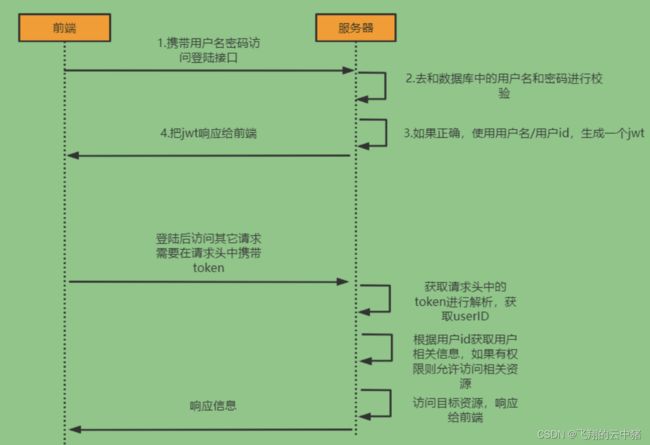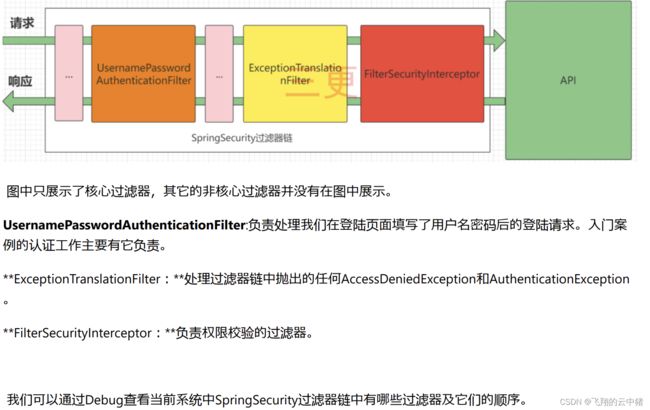spring security教程(一)--认证
零.简介
【1】简介
【2】登录校验流程
【3】原理(入门的时候先了解一下就好)
一.思路分析
二.建表
确保你已经建立好一张用户表,并且引入springboot,mybatis,mp,slf4j等基础依赖。
即使你有多个角色你也可以将他们的相同信息(如用户名密码登都提取到一张表中)。并根据表编写对应实体类和mapper。
![]()
上面是我建立的我的user表,我把学生,督导,老师,辅导员的相同信息提取到一张表中。
@Data
@NoArgsConstructor
@AllArgsConstructor
@TableName("user")
public class User {
@TableId(type = IdType.AUTO)
private Integer id;
private String no;
private String password;
private String name;
private String gender;
private String college;
private String userType;
}@Mapper
public interface UserMapper extends BaseMapper {
} 三.引入依赖
com.alibaba
fastjson
1.2.62
junit
junit
test
下面这个依赖不用写版本是因为这个依赖继承spring boot,而springboot中已经有版本管理了
org.springframework.boot
spring-boot-starter-data-redis
org.springframework.boot
spring-boot-starter-security
io.jsonwebtoken
jjwt
0.9.1
四.工具类
【1】redis
(1)redis使用FastJson序列化配置
package com.flyingpig.util;
import com.alibaba.fastjson.JSON;
import com.alibaba.fastjson.serializer.SerializerFeature;
import com.fasterxml.jackson.databind.JavaType;
import com.fasterxml.jackson.databind.ObjectMapper;
import com.fasterxml.jackson.databind.type.TypeFactory;
import org.springframework.data.redis.serializer.RedisSerializer;
import org.springframework.data.redis.serializer.SerializationException;
import com.alibaba.fastjson.parser.ParserConfig;
import org.springframework.util.Assert;
import java.nio.charset.Charset;
/**
* Redis使用FastJson序列化
*
*/
public class FastJsonRedisSerializer implements RedisSerializer
{
public static final Charset DEFAULT_CHARSET = Charset.forName("UTF-8");
private Class clazz;
static
{
ParserConfig.getGlobalInstance().setAutoTypeSupport(true);
}
public FastJsonRedisSerializer(Class clazz)
{
super();
this.clazz = clazz;
}
@Override
public byte[] serialize(T t) throws SerializationException
{
if (t == null)
{
return new byte[0];
}
return JSON.toJSONString(t, SerializerFeature.WriteClassName).getBytes(DEFAULT_CHARSET);
}
@Override
public T deserialize(byte[] bytes) throws SerializationException
{
if (bytes == null || bytes.length <= 0)
{
return null;
}
String str = new String(bytes, DEFAULT_CHARSET);
return JSON.parseObject(str, clazz);
}
protected JavaType getJavaType(Class clazz)
{
return TypeFactory.defaultInstance().constructType(clazz);
}
} (2)redis配置类--如果没有redis配置类,不同方法中的redis数据还是不能共用
package com.flyingpig.config;
import com.flyingpig.util.FastJsonRedisSerializer;
import org.springframework.context.annotation.Bean;
import org.springframework.context.annotation.Configuration;
import org.springframework.data.redis.connection.RedisConnectionFactory;
import org.springframework.data.redis.core.RedisTemplate;
import org.springframework.data.redis.serializer.StringRedisSerializer;
@Configuration
public class RedisConfig {
@Bean
@SuppressWarnings(value = { "unchecked", "rawtypes" })
public RedisTemplate redisTemplate(RedisConnectionFactory connectionFactory)
{
RedisTemplate template = new RedisTemplate<>();
template.setConnectionFactory(connectionFactory);
FastJsonRedisSerializer serializer = new FastJsonRedisSerializer(Object.class);
// 使用StringRedisSerializer来序列化和反序列化redis的key值
template.setKeySerializer(new StringRedisSerializer());
template.setValueSerializer(serializer);
// Hash的key也采用StringRedisSerializer的序列化方式
template.setHashKeySerializer(new StringRedisSerializer());
template.setHashValueSerializer(serializer);
template.afterPropertiesSet();
return template;
}
} (3)redis工具类
package com.flyingpig.util;
import org.springframework.beans.factory.annotation.Autowired;
import org.springframework.data.redis.core.BoundSetOperations;
import org.springframework.data.redis.core.HashOperations;
import org.springframework.data.redis.core.RedisTemplate;
import org.springframework.data.redis.core.ValueOperations;
import org.springframework.stereotype.Component;
import java.util.*;
import java.util.concurrent.TimeUnit;
@SuppressWarnings(value = { "unchecked", "rawtypes" })
@Component
public class RedisCache
{
@Autowired
public RedisTemplate redisTemplate;
/**
* 缓存基本的对象,Integer、String、实体类等
*
* @param key 缓存的键值
* @param value 缓存的值
*/
public void setCacheObject(final String key, final T value)
{
redisTemplate.opsForValue().set(key, value);
}
/**
* 缓存基本的对象,Integer、String、实体类等
*
* @param key 缓存的键值
* @param value 缓存的值
* @param timeout 时间
* @param timeUnit 时间颗粒度
*/
public void setCacheObject(final String key, final T value, final Integer timeout, final TimeUnit timeUnit)
{
redisTemplate.opsForValue().set(key, value, timeout, timeUnit);
}
/**
* 设置有效时间
*
* @param key Redis键
* @param timeout 超时时间
* @return true=设置成功;false=设置失败
*/
public boolean expire(final String key, final long timeout)
{
return expire(key, timeout, TimeUnit.SECONDS);
}
/**
* 设置有效时间
*
* @param key Redis键
* @param timeout 超时时间
* @param unit 时间单位
* @return true=设置成功;false=设置失败
*/
public boolean expire(final String key, final long timeout, final TimeUnit unit)
{
return redisTemplate.expire(key, timeout, unit);
}
/**
* 获得缓存的基本对象。
*
* @param key 缓存键值
* @return 缓存键值对应的数据
*/
public T getCacheObject(final String key)
{
ValueOperations operation = redisTemplate.opsForValue();
return operation.get(key);
}
/**
* 删除单个对象
*
* @param key
*/
public boolean deleteObject(final String key)
{
return redisTemplate.delete(key);
}
/**
* 删除集合对象
*
* @param collection 多个对象
* @return
*/
public long deleteObject(final Collection collection)
{
return redisTemplate.delete(collection);
}
/**
* 缓存List数据
*
* @param key 缓存的键值
* @param dataList 待缓存的List数据
* @return 缓存的对象
*/
public long setCacheList(final String key, final List dataList)
{
Long count = redisTemplate.opsForList().rightPushAll(key, dataList);
return count == null ? 0 : count;
}
/**
* 获得缓存的list对象
*
* @param key 缓存的键值
* @return 缓存键值对应的数据
*/
public List getCacheList(final String key)
{
return redisTemplate.opsForList().range(key, 0, -1);
}
/**
* 缓存Set
*
* @param key 缓存键值
* @param dataSet 缓存的数据
* @return 缓存数据的对象
*/
public BoundSetOperations setCacheSet(final String key, final Set dataSet)
{
BoundSetOperations setOperation = redisTemplate.boundSetOps(key);
Iterator it = dataSet.iterator();
while (it.hasNext())
{
setOperation.add(it.next());
}
return setOperation;
}
/**
* 获得缓存的set
*
* @param key
* @return
*/
public Set getCacheSet(final String key)
{
return redisTemplate.opsForSet().members(key);
}
/**
* 缓存Map
*
* @param key
* @param dataMap
*/
public void setCacheMap(final String key, final Map dataMap)
{
if (dataMap != null) {
redisTemplate.opsForHash().putAll(key, dataMap);
}
}
/**
* 获得缓存的Map
*
* @param key
* @return
*/
public Map getCacheMap(final String key)
{
return redisTemplate.opsForHash().entries(key);
}
/**
* 往Hash中存入数据
*
* @param key Redis键
* @param hKey Hash键
* @param value 值
*/
public void setCacheMapValue(final String key, final String hKey, final T value)
{
redisTemplate.opsForHash().put(key, hKey, value);
}
/**
* 获取Hash中的数据
*
* @param key Redis键
* @param hKey Hash键
* @return Hash中的对象
*/
public T getCacheMapValue(final String key, final String hKey)
{
HashOperations opsForHash = redisTemplate.opsForHash();
return opsForHash.get(key, hKey);
}
/**
* 删除Hash中的数据
*
* @param key
* @param hkey
*/
public void delCacheMapValue(final String key, final String hkey)
{
HashOperations hashOperations = redisTemplate.opsForHash();
hashOperations.delete(key, hkey);
}
/**
* 获取多个Hash中的数据
*
* @param key Redis键
* @param hKeys Hash键集合
* @return Hash对象集合
*/
public List getMultiCacheMapValue(final String key, final Collection 【2】JWT
package com.flyingpig.util;
import io.jsonwebtoken.Claims;
import io.jsonwebtoken.JwtBuilder;
import io.jsonwebtoken.Jwts;
import io.jsonwebtoken.SignatureAlgorithm;
import javax.crypto.SecretKey;
import javax.crypto.spec.SecretKeySpec;
import java.util.Base64;
import java.util.Date;
import java.util.Map;
import java.util.UUID;
public class JwtUtil {
//有效期为
public static final Long JWT_TTL = 60 * 60 *1000L;// 60 * 60 *1000 一个小时
//设置秘钥明文
public static final String JWT_KEY = "Zmx5aW5ncGln";//flyingpig
public static String getUUID(){
String token = UUID.randomUUID().toString().replaceAll("-", "");
return token;
}
/**
* 生成jtw
* @param subject token中要存放的数据(json格式)
* @return
*/
public static String createJWT(String subject) {
JwtBuilder builder = getJwtBuilder(subject, null, getUUID());// 设置过期时间
return builder.compact();
}
/**
* 生成jtw
* @param subject token中要存放的数据(json格式)
* @param ttlMillis token超时时间
* @return
*/
public static String createJWT(String subject, Long ttlMillis) {
JwtBuilder builder = getJwtBuilder(subject, ttlMillis, getUUID());// 设置过期时间
return builder.compact();
}
private static JwtBuilder getJwtBuilder(String subject, Long ttlMillis, String uuid) {
SignatureAlgorithm signatureAlgorithm = SignatureAlgorithm.HS256;
SecretKey secretKey = generalKey();
long nowMillis = System.currentTimeMillis();
Date now = new Date(nowMillis);
if(ttlMillis==null){
ttlMillis=JwtUtil.JWT_TTL;
}
long expMillis = nowMillis + ttlMillis;
Date expDate = new Date(expMillis);
return Jwts.builder()
.setId(uuid) //唯一的ID
.setSubject(subject) // 主题 可以是JSON数据
.setIssuer("flyingpig") // 签发者
.setIssuedAt(now) // 签发时间
.signWith(signatureAlgorithm, secretKey) //使用HS256对称加密算法签名, 第二个参数为秘钥
.setExpiration(expDate);
}
/**
* 创建token
* @param id
* @param subject
* @param ttlMillis
* @return
*/
public static String createJWT(String id, String subject, Long ttlMillis) {
JwtBuilder builder = getJwtBuilder(subject, ttlMillis, id);// 设置过期时间
return builder.compact();
}
public static void main(String[] args) throws Exception {
String jwtKey = "flyingpig";
String encodedKey = Base64.getEncoder().encodeToString(jwtKey.getBytes());
System.out.println(encodedKey);
}
/**
* 生成加密后的秘钥 secretKey
* @return
*/
public static SecretKey generalKey() {
byte[] encodedKey = Base64.getDecoder().decode(JwtUtil.JWT_KEY);
SecretKey key = new SecretKeySpec(encodedKey, 0, encodedKey.length, "AES");
return key;
}
//解析JWT令牌
public static Claims parseJwt(String jwt) {
SecretKey secretKey = generalKey();
return Jwts.parser()
.setSigningKey(secretKey)
.parseClaimsJws(jwt)
.getBody();
}
}
【3】WebUtils
package com.flyingpig.util;
import javax.servlet.http.HttpServletResponse;
import java.io.IOException;
public class WebUtils
{
/**
* 将字符串渲染到客户端,往响应当中去写入数据
*
* @param response 渲染对象
* @param string 待渲染的字符串
* @return null
*/
public static String renderString(HttpServletResponse response, String string) {
try
{
response.setStatus(200);
response.setContentType("application/json");
response.setCharacterEncoding("utf-8");
response.getWriter().print(string);
}
catch (IOException e)
{
e.printStackTrace();
}
return null;
}
}五.核心代码实现
1.编写UserDetailsServiceImpl实现UserDetailsService接口--通过用户名从数据库查询信息
package com.flyingpig.service.serviceImpl;
import com.baomidou.mybatisplus.core.conditions.query.QueryWrapper;
import com.flyingpig.dto.LoginUser;
import com.flyingpig.mapper.UserMapper;
import com.flyingpig.untity.User;
import org.springframework.beans.factory.annotation.Autowired;
import org.springframework.security.core.userdetails.UserDetails;
import org.springframework.security.core.userdetails.UserDetailsService;
import org.springframework.security.core.userdetails.UsernameNotFoundException;
import org.springframework.stereotype.Service;
import java.util.List;
import java.util.Objects;
@Service
public class UserDetailsServiceImpl implements UserDetailsService {
@Autowired
private UserMapper userMapper;
@Override
public UserDetails loadUserByUsername(String username) throws UsernameNotFoundException{
//查询用户信息
QueryWrapper queryWrapper = new QueryWrapper<>();
queryWrapper.eq("no",username);
User user = userMapper.selectOne(queryWrapper);
//如果没有查询到用户就抛出异常
if(Objects.isNull(user)){
throw new RuntimeException("用户名或者密码错误");
}
//TODO 根据用户查询权限信息,添加到LoginUser中
//把数据封装成UserDetails返回
return new LoginUser(user);
}
}
2.编写LoginUser实现UserDetails接口--封装用户信息
@Data
@NoArgsConstructor
@AllArgsConstructor
public class LoginUser implements UserDetails {
private User user;
//获取用户权限
@Override
public Collection getAuthorities() {
return null;
}
//判断用户名和密码是否没过期
@Override
public boolean isAccountNonExpired() {
return true;
}
//返回用户名
@Override
public String getUsername(){
return user.getNo();
}
//返回密码
@Override
public String getPassword(){
return user.getPassword();
}
@Override
public boolean isAccountNonLocked() {
return true;
}
@Override
public boolean isCredentialsNonExpired() {
return true;
}
@Override
public boolean isEnabled() {
return true;
}
}3.编写登录和登出接口LoginController
@RestController
@CrossOrigin(origins = "*", allowedHeaders = "*")
@RequestMapping("/user")
public class LoginController {
@Autowired
private LoginServcie loginServcie;
@PostMapping("/login")
public Result login(@RequestBody User user) {
return loginServcie.login(user);
}
@RequestMapping("/logout")
public Result logout(){
return loginServcie.logout();
}
}4.编写SecurityConfig继承WebSecurityConfigurerAdapter接口--确定密码加密方式并让spring security对登录接口允许匿名访问
里面有各段代码的详细解释
@Configuration
public class SecurityConfig extends WebSecurityConfigurerAdapter {
@Bean
public PasswordEncoder passwordEncoder(){
return new BCryptPasswordEncoder();
}
@Override
protected void configure(HttpSecurity http) throws Exception {
http
//关闭csrf
.csrf().disable()
//不会创建HttpSession并且不通过Session获取SecurityContext对象,因为前后端分离基本session就已经灭有用了
.sessionManagement().sessionCreationPolicy(SessionCreationPolicy.STATELESS)
.and()
.authorizeRequests()//对请求认证规则进行相应配置
//1.对于登录,修改密码和注册接口放行(antMatchers)
// 并且在后面加上anonymous方法允许匿名访问而不允许在已登录状态访问
//简单说加上anonymous在没有token的情况下可以访问,携带token反而不能访问,一般用于登录注册接口之类的
//与之相对应的是加上permiAll(),加上后这个接口有无token(有无身份)都可以访问,一般用于静态资源的放行
.antMatchers("/user/login").anonymous()
//2.除上面外的所有请求任意的用户认证之后可以访问
//后面会进行精细化授权
.anyRequest().authenticated();
}
@Bean
@Override
public AuthenticationManager authenticationManagerBean() throws Exception {
return super.authenticationManagerBean();
}
}5.编写LoginService及其impl
public interface LoginService {
Result login(User user);
Result logout();
}@Service
public class LoginServiceImpl implements LoginService {
@Autowired
private AuthenticationManager authenticationManager;
@Autowired
private RedisCache redisCache;
@Override
public Result login(User user) {
//AuthenticationManager authenticate进行用户认证
UsernamePasswordAuthenticationToken authenticationToken = new UsernamePasswordAuthenticationToken(user.getNo(),user.getPassword());
Authentication authenticate = authenticationManager.authenticate(authenticationToken);
//如果认证没通过,给出对应的提示
if(Objects.isNull(authenticate)){
throw new RuntimeException("登录失败");
}
//如果认证通过了,使用userid生成一个jwt jwt存入ResponseResult返回
LoginUser loginUser = (LoginUser) authenticate.getPrincipal();
String userid = loginUser.getUser().getId().toString();
String jwt = JwtUtil.createJWT(userid);
Map map = new HashMap<>();
map.put("token",jwt);
//把完整的用户信息存入redis userid作为key
redisCache.setCacheObject("login:"+userid,loginUser);
return Result.success(map);
}
@Override
public Result logout() {
Authentication authentication = SecurityContextHolder.getContext().getAuthentication();
LoginUser loginUser = (LoginUser) authentication.getPrincipal();
Integer userid = loginUser.getUser().getId();
redisCache.deleteObject("login:"+userid);
return new Result(200,"退出成功",null);
}
} 6.测试接口
下载redis,并启动redis-server,用postman发送请求,返回token
注意请求体要写对,不然接口会403报错
7.认证JwtAuthenticationTokenFilter继承OncePerRequestFilter--自定义认证过滤器
这个过滤器会去获取请求头中的token,对token进行解析取出其中的userid。使用userid去redis获取对应的LoginUser对象,然后封装Authentication对象存入SecurityContextHolder。
@Component
public class JwtAuthenticationTokenFilter extends OncePerRequestFilter {
@Autowired
private RedisCache redisCache;
@Override
protected void doFilterInternal(HttpServletRequest request, HttpServletResponse response, FilterChain filterChain) throws ServletException, IOException {
//获取请求路径
String requestPath = request.getRequestURI();
//判断请求路径是否为"/user/login"
if (requestPath.equals("/user/login")) {
//放行"/user/login"请求
filterChain.doFilter(request, response);
return;
}
//获取token
String authorization = request.getHeader("Authorization");
String token = authorization.replace("Bearer ", "");
if (!StringUtils.hasText(token)) {
//放行
filterChain.doFilter(request, response);
return;
}
//解析token
String userid;
try {
Claims claims = JwtUtil.parseJwt(token);
userid = claims.getSubject();
} catch (Exception e) {
e.printStackTrace();
throw new RuntimeException("token非法");
}
//从redis中获取用户信息
String redisKey = "login:" + userid;
LoginUser loginUser = redisCache.getCacheObject(redisKey);
if(Objects.isNull(loginUser)){
throw new RuntimeException("用户未登录");
}
//存入SecurityContextHolder
//TODO 获取权限信息封装到Authentication中
UsernamePasswordAuthenticationToken authenticationToken =
new UsernamePasswordAuthenticationToken(loginUser,null,loginUser.getAuthorities());
SecurityContextHolder.getContext().setAuthentication(authenticationToken);
//放行
filterChain.doFilter(request, response);
}
}这个token校验过滤器会自动添加到过滤器链中
注意:我这里token传过来使用的格式是:Authorization: Bearer
当然你也可以简单的使用:token:
六.补充
1.从Redis中获取到loginUser的信息
在其他接口中,你可以通过以下步骤来从缓存中获取 `loginUser`:
1. 首先,确保已经注入了RedisCache对象。可以使用@Autowired注解将RedisCache注入到其他接口的类中。
@Autowired
private RedisCache redisCache;2. 在需要实现loginSeriveImpl接口中,通过用户的userid构建缓存的 key 值,前面已经写好了
//把完整的用户信息存入redis userid作为key
redisCache.setCacheObject("login:"+userid,loginUser);即里面的这行代码。
3. 在需要用到loginUser的地方使用redisCache对象从缓存中获取loginUser
LoginUser loginUser = redisCache.getCacheObject(cacheKey);4. 确认获取到了 `loginUser`
if (Objects.isNull(loginUser)) {
// 缓存中没有对应的登录信息
// 处理缓存中没有登录信息的情况
} else {
// 缓存中有对应的登录信息
// 处理缓存中的登录信息
}在处理缓存中没有登录信息的情况下,你可以根据实际需求进行错误处理或者重新进行用户认证。
2.解决跨域问题
资料--什么是跨域问题?
【1】在只有springboot的时候只需要在springboot中处理跨域问题即可。
@Configuration
public class CorsConfig {
/**
* 允许跨域调用的过滤器
*/
@Bean
public CorsFilter corsFilter() {
CorsConfiguration config = new CorsConfiguration();
//允许白名单域名进行跨域调用
config.addAllowedOriginPattern("*");
//允许跨越发送cookie
config.setAllowCredentials(true);
//放行全部原始头信息
config.addAllowedHeader("*");
//允许所有请求方法跨域调用
config.addAllowedMethod("*");
UrlBasedCorsConfigurationSource source = new UrlBasedCorsConfigurationSource();
source.registerCorsConfiguration("/**", config);
return new CorsFilter(source);
}
}【2】加入springsecurity之后,除了要上面的类,还需要在前面的SecurityConfig的config方法中允许跨域:
//允许跨域
http.cors();配置类中的完整代码如下:
@Configuration
public class SecurityConfig extends WebSecurityConfigurerAdapter {
@Bean
public PasswordEncoder passwordEncoder(){
return new BCryptPasswordEncoder();
}
@Autowired
JwtAuthenticationTokenFilter jwtAuthenticationTokenFilter;
@Override
protected void configure(HttpSecurity http) throws Exception {
http
//关闭csrf
.csrf().disable()
//不通过Session获取SecurityContext
.sessionManagement().sessionCreationPolicy(SessionCreationPolicy.STATELESS)
.and()
.authorizeRequests()
// 对于登录接口 允许匿名访问
.antMatchers("/user/login").anonymous()
// 除上面外的所有请求全部需要鉴权认证
.anyRequest().authenticated();
//把token校验过滤器添加到过滤器链中
http.addFilterBefore(jwtAuthenticationTokenFilter, UsernamePasswordAuthenticationFilter.class);
//允许跨域
http.cors();
}
@Bean
@Override
public AuthenticationManager authenticationManagerBean() throws Exception {
return super.authenticationManagerBean();
}
}





